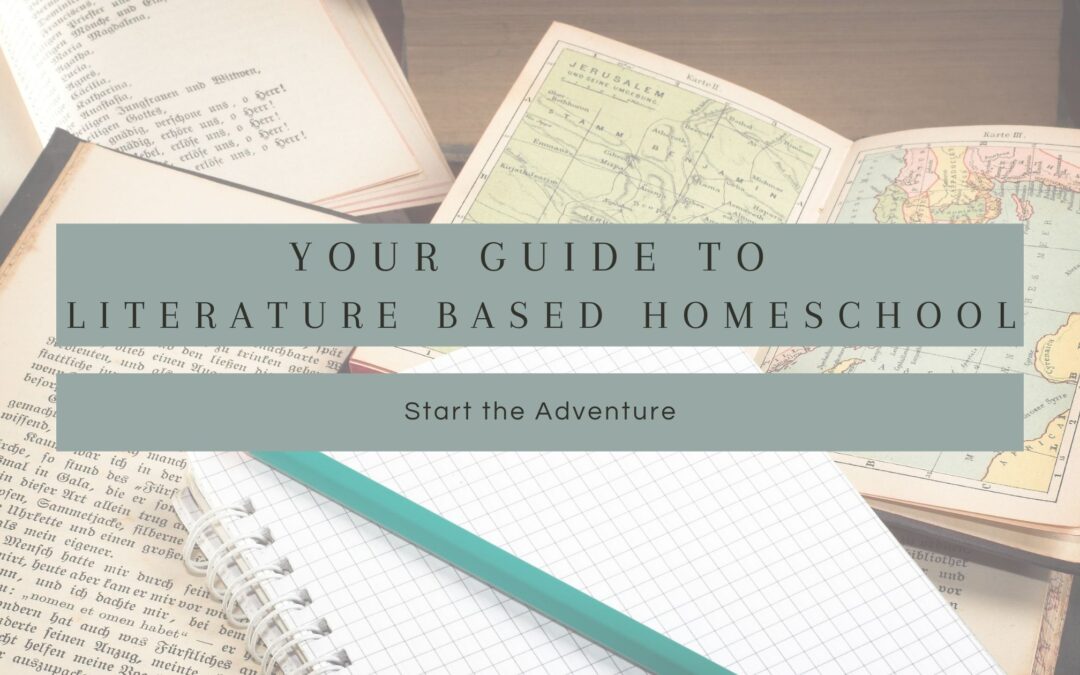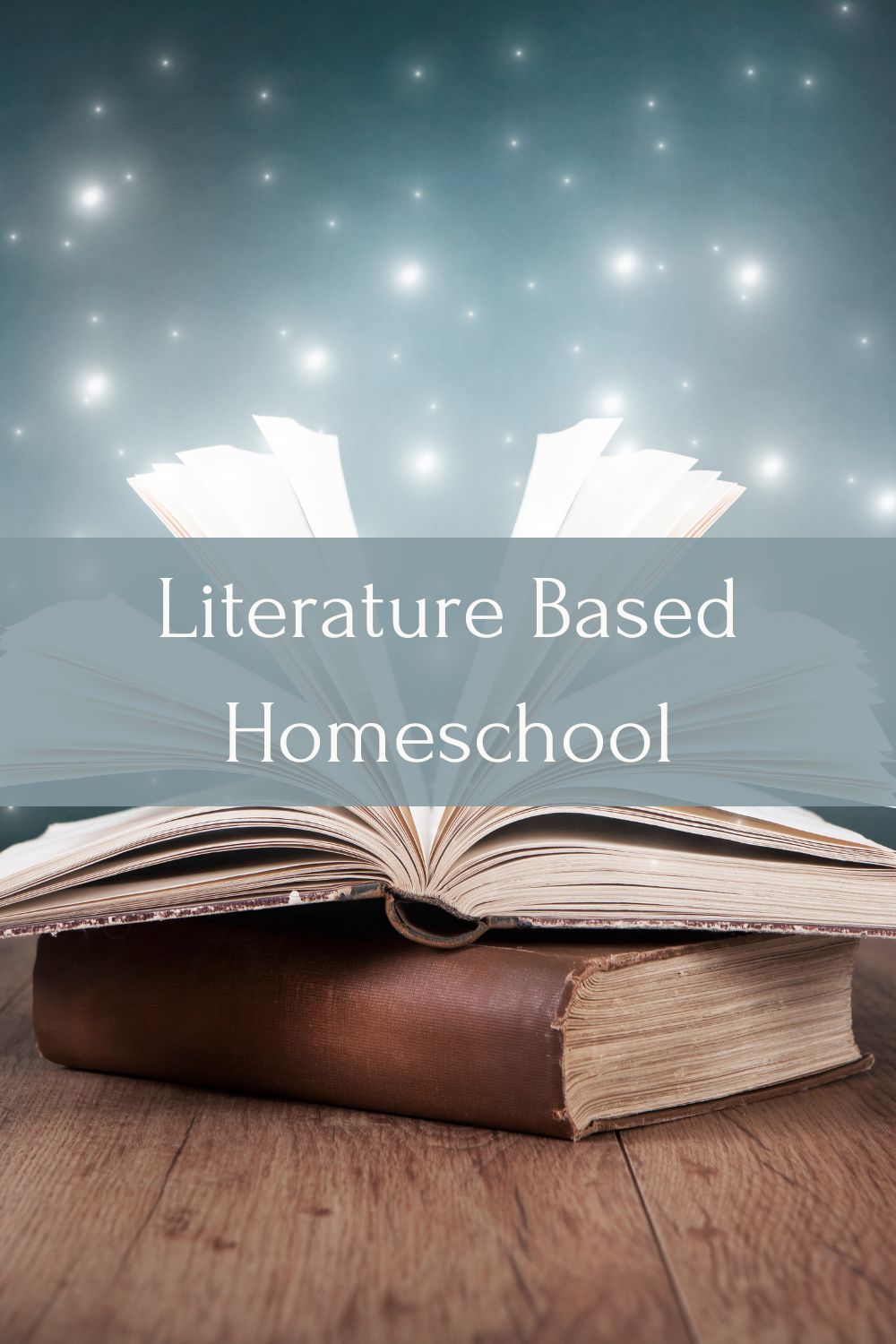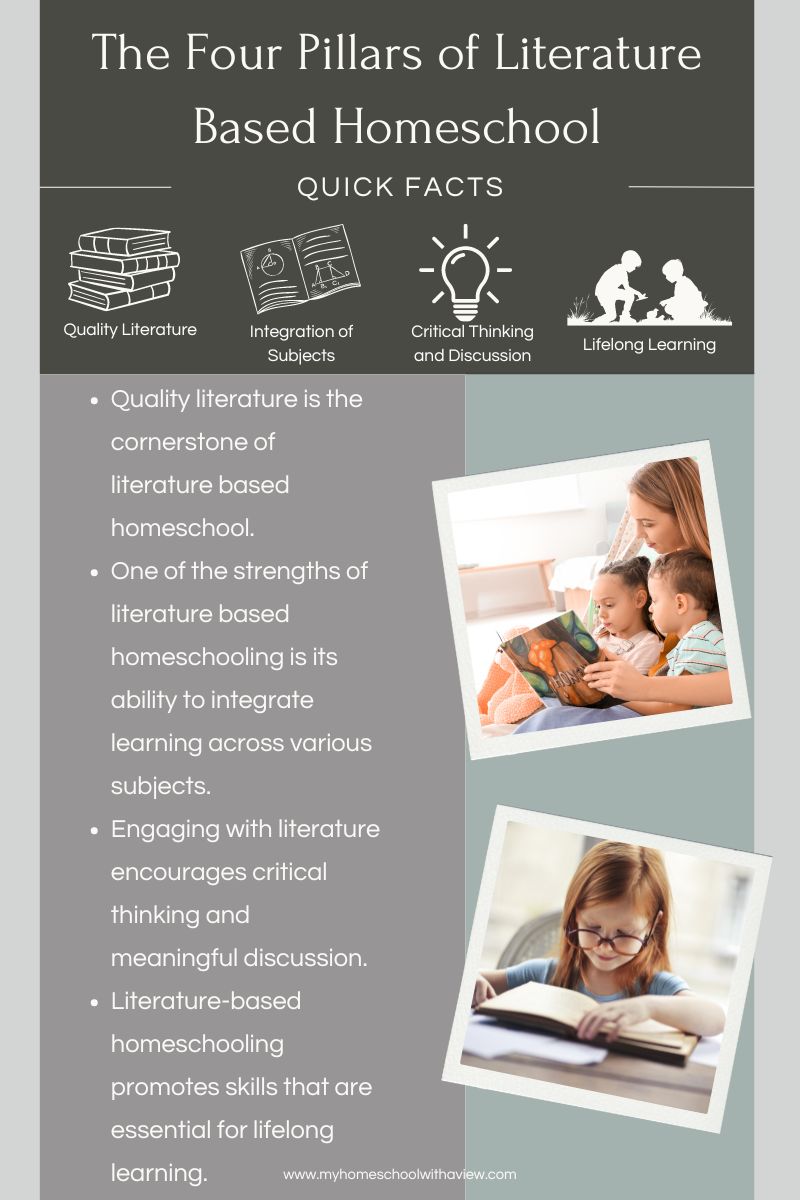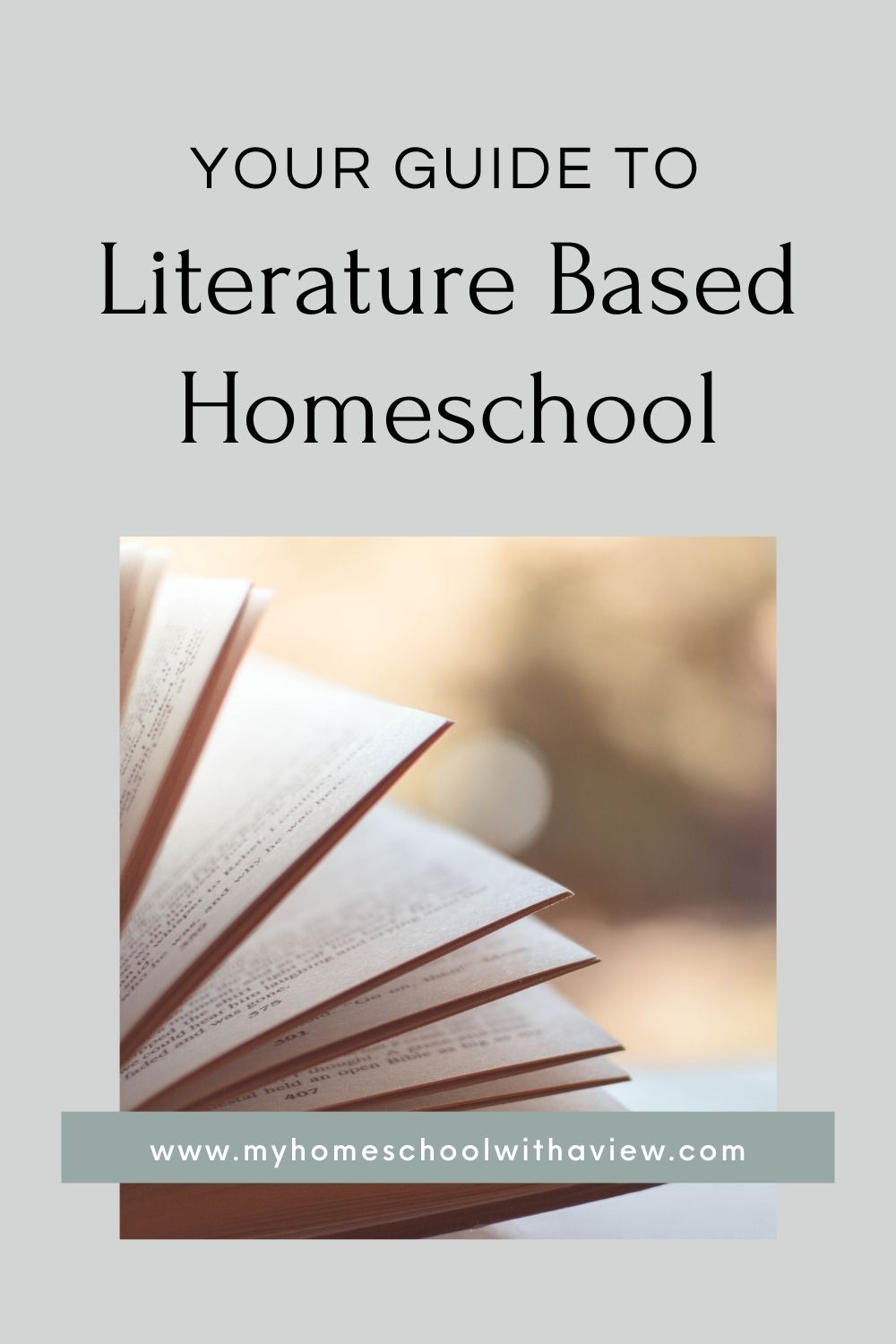This post is all about literature based homeschool.
This post contains affiliate links and My Homeschool with a View, LLC participates in the Amazon Associates program. If you make a qualifying purchase through our links, we earn a commission at no additional cost to you . Thank you for supporting this site! You can read my affiliate and advertising disclosure here.
Literature based homeschool is one of the most enriching homeschool styles. Homeschooling with great books provides a rich and holistic homeschool experience.
I have always had at least a mostly literature based homeschool. It has looked different year to year, but good books are always foundational to how I homeschool.
While literature based homeschooling might draw many similarities to the Charlotte Mason method, literature based is more of a spin off of this method. Literature based homeschool allows more flexibility to choose modern literature, use different language arts methods, and it feels like more of a homeschool method than joining a club.
Literature based homeschool is easy to mix and match with other homeschool styles. You can do a purist approach and teach all subjects with great literature, or you can add great literature to a traditional approach or add it to a unit study.
If you and your kids like reading great books and want to use them as a foundation to your homeschool, then this is for you. In this post you will learn how to have a literature based homeschool, and how to implement this homeschool method.
This post is all about getting started with the literature based homeschool method.
What is Literature Based Homeschool?
Literature based homeschool immerses our kids in rich, engaging stories to teach everything from history to science. Instead of relying on textbooks and worksheets, this approach uses classic and modern literature to cover a wide range of topics.
By reading carefully curated books, our kids encounter various subjects in a more natural and enjoyable context. This homeschool style allows for exploring complex ideas, cultures, and historical events through the eyes of characters they grow to care about. This approach builds connection, making learning more memorable and meaningful.
Moreover, literature-based homeschooling encourages our kids to think critically and make connections between different subjects. The result is often that our kids are learning how to think, not what to think. Instead of spoon feeding them with what to learn, they are connecting with the lessons of a story.
For example, a historical novel might prompt discussions about geography, social customs, and ethical dilemmas, all within the framework of the story. This interconnected learning helps us see the relevance of what we are studying and understand how different areas of knowledge are related.
Furthermore, engaging with literature enhances vocabulary, improves reading comprehension, and brings a love for storytelling, all of which are essential skills for future academic success.
Having good writing as a model improves grammar, spelling and writing skills. I always say, voracious readers usually become good writers. Some kids learn best through this type of modeled instruction as opposed to direct instruction.
The Four Pillars of Literature Based Homeschool
1. Quality Literature
Quality literature is the cornerstone of a literature based homeschool. This includes classic and contemporary books that are well-written and engaging. These books should provide rich language, compelling narratives, and thoughtful themes.
When selecting literature, consider a variety of genres and formats, including novels, picture books, poetry, and non-fiction. High-quality literature not only captivates the imagination but also provides valuable insights into different cultures, historical periods, and human experiences.
Example:
- Classic: Little Women by Louisa May Alcott
- Contemporary: From the Mixed-Up Files of Mrs. Basil E. Frankweiler by E.L. Konisburg
- Poetry: Where the Sidewalk Ends by Shel Silverstein
- Non-fiction: The Boy Who Harnessed the Wind by William Kamkwamba
2. Integration Across Subjects
One of the strengths of literature based homeschooling is its ability to integrate books across various subjects. Good books can serve as a springboard for lessons in history, science, art, and even math.
Example: Reading Island of the Blue Dolphins by Scott O’Dell can lead to:
- History: Learning about Native American tribes and their cultures.
- Science: Studying the ecosystem of the Channel Islands.
- Art: Drawing or painting the island setting.
- Math: Calculating distances and creating maps of the island.
3. Critical Thinking and Discussion
Engaging with literature encourages critical thinking and meaningful discussion. Through reading, kids learn to analyze characters, plot, and themes. They develop the ability to think deeply about what they read, ask questions, and form their own opinions. Discussions about books provide opportunities for children to articulate their thoughts, listen to others, and refine their understanding.
Example: While reading The Lion, the Witch and the Wardrobe by C.S. Lewis, prompt discussions about:
- Character Analysis: How do the characters change throughout the story? What motivates their actions?
- Themes: What are the major themes of the book, such as good versus evil or sacrifice?
- Personal Reflection: How do the events in the story relate to your own life? What lessons can be learned?
4. Lifelong Learning Skills
Literature based homeschooling promotes skills that are essential for lifelong learning. This includes curiosity, developing research skills, and encouraging independent thinking.
By engaging with diverse literary works, children learn to seek out information, evaluate sources, and think critically about various topics. These skills are crucial not only for academic success but also for navigating the complexities of everyday life.
Example: While studying Anne of Green Gables by L.M. Montgomery:
- Research Skills: Research the historical context of Prince Edward Island in the late 19th century.
- Curiosity: Explore themes of nature and imagination by visiting local gardens or creating a nature journal.
- Independent Thinking: Encourage children to form their own opinions about Anne’s adventures and the decisions she makes.
Benefits of Literature Based Homeschooling
Developing a Love for Reading
By making literature appealing and exposing our kids to a wide variety of books, literature based homeschooling cultivates a love for reading. If our kids are willing and happy to read, they can truly learn anything in life.
When we give our kids stories they enjoy, they are more likely to develop a lifelong passion for books. This love for reading can enhance their overall homeschool and life experience.
Building Critical Thinking Skills
Engaging with complex narratives helps kids develop critical thinking and analytical skills. As they read, they learn to understand different perspectives, analyze characters’ actions, and predict outcomes. These skills are essential, not just for academic success, but also real-world problem-solving.
Creating Lifelong Learners
Literature based learning gives kids a healthy curiosity and a lifelong passion for pursuing knowledge. When they discover new ideas and cultures they connect with through books, they become more interested in diving deeper into these concepts. This curiosity drives them to continue learning throughout their lives.
Getting Started with Literature Based Homeschool
Choosing the Right Books
Selecting high-quality literature is the foundation for a successful literature based homeschool experience. Look for books that are well-written, with relatable and diverse characters, and an intriguing plot.
Books can be a variety of classic and modern literature. Many times when we think of literature our minds automatically go to old classic tales written hundreds of years ago. This doesn’t have to be the case. Both modern and classic literature are beneficial to a literature based homeschool.
I often find that modern literature is more engaging because it is relatable. As kids grow in their reading they become more interested in the classics, but modern literature is a great place to start.
Choosing Literature Based Homeschool Subjects
Deciding which subjects you want to cover with literature is the first step in setting up your literature based homeschool routine. For example, what era of history do you plan to cover this year? Which science topics? Are you planning to use a language arts curriculum or are you going to create lessons based on book passages you are reading? Don’t forget to choose electives as well.
Once you figure out the answers to those questions, you can start compiling your book list. I have often pulled from various publishers’ book lists to create my own plan. You can also go with a curriculum in a box like Sonlight or BookShark if you prefer not to take the time to plan everything on your own.
Planning Your Literature Based Homeschool Lessons
Here is what a day of literature based homeschool lessons might look like:
History: If you are studying about castles you might read from Castle by David Maculay as your main spine. Then children might read books like Castle Diary: The Journey of Tobias Burgess depending on their age to give context and relatability to what life was like in a castle.
Science: A science spine might be a children’s encyclopedia, DK books specific to the topic being studied, or even a textbook. You would then add literature to round out the topic.
For example, if you were studying birds you could add a biography of John James Audubon to a spine book about birds.
Language Arts: If you like to lesson plan, you can find a list of language arts skills for each grade level and create activities from the books you are reading. You can create spelling words, copywriting, grammar and writing activities based on novels.
If you are like me and don’t like to lesson plan, there are plenty of publishers who have already created novel unit studies that you can pick and choose from.
And if you are even more like me and prefer to have everything done for you, curriculum publishers like Sonlight or BookShark have all of this integrated into the curriculum already.
Electives: It is easy to incorporate electives into your literature based homeschooling. It all comes down to choosing a topic, and choosing great literature to deep dive into the topic.
Literature Based Unit Studies
Integrating Subjects through Stories
As I mentioned in the post intro, literature based homeschooling integrates easily with other homeschool styles. In my experience, a lot of people create unit studies around literature.
Unit studies use books to explore multiple subjects, making learning more cohesive and enjoyable. For example, reading a historical novel can lead to lessons in history, geography, social studies, science and language arts.
Rather than using a different book for each subject, you read one book and base your entire unit on that book. This integrated approach lets kids dive deep into a topic and see the connections between different areas of knowledge.
Example Unit Study: The American Revolution
Using historical novels and biographies to teach about the American Revolution provides a more immersive learning experience. Books like Johnny Tremain by Esther Forbes or George Washington’s Socks by Elvira Woodruff bring history to life. Supplement the reading with activities like map-making, writing letters from a soldier’s perspective, and visiting historical sites.
Literature Based Art Projects for Kids
Bringing Stories to Life through Art
Art projects inspired by books are a really fun way to help kids connect with what they read. Creating visual representations of the stories they read deepens comprehension and retention of the material.
Reading artist biographies and completing art projects based on the artist’s style is also another fun way to connect art and literature. Getting to Know the World’s Greatest Artists series by Mike Venezia is an excellent series for artist biographies.
You can follow my Pinterest board for literature based art ideas.
Example Art Project: Drawing Scenes from Charlotte's Web
Creating drawings of key scenes from Charlotte’s Web is a fun way to encourage listening and build comprehension skills. They can illustrate their favorite parts of the book, such as Wilbur meeting Charlotte or the county fair.
Literature-Based Preschool
Introducing Young Children to Literature
Literature based learning should start when our kids are infants. Creating a family culture of reading aloud develops a love for literature and words as our children grow.
I started reading to my oldest when he was a tiny newborn which resulted in him growing a big vocabulary and love for great books. He still loves reading and talking as a sixteen year old.
Example Activities for Preschoolers
As kids reach preschool age, you can start tying activities to picture books. This is my favorite way to add some informal learning to the preschool years.
Simple activities like storytime and related crafts make literature-based learning fun for young children. Read aloud books like Goodnight Moon by Margaret Wise Brown or The Very Hungry Caterpillar by Eric Carle, and then do crafts that relate to the story. For example, after reading The Very Hungry Caterpillar, children can create their own caterpillar using paper and paint.
Finding and Using Literature Based Resources
Online Resources
Websites like Project Gutenberg and LibriVox offer free access to classic literature. These resources provide a huge collection of books that can be used in your literature based homeschool curriculum. Additionally, many libraries have digital collections that you can access from home.
Homeschool Curricula
Several homeschool curricula are specifically designed around literature-based learning, such as Sonlight and Five in a Row. These programs provide book lists, lesson plans, and activities that make it easier to implement a literature-based approach in your homeschool.
Incorporating Literature Based Homeschooling into Your Life
Adapting to Different Learning Styles
Literature based homeschooling can be tailored to fit various learning styles and needs. For visual learners, incorporate illustrations and picture books. For auditory learners, use audiobooks and read-aloud sessions. Kinesthetic learners can benefit from hands-on activities related to the books they read.
Balancing Literature with Other Educational Methods
As mentioned earlier in this post, literature based homeschool can stand on its own, or compliment other homeschooling styles. As an eclectic homeschooler, I never stick to one method or style, but I always incorporate good literature to go along with our homeschooling.
Content subjects, like science and history lend themselves extremely well to literature based lessons. These subjects are well received when taught through engaging stories, especially in the early years.
Frequently Asked Questions (FAQ) about Literature Based Homeschool
Q: Can I use literature based homeschool for all subjects?
A: Yes, literature can be used to teach a wide range of subjects, including history, science, and even math through story-based problems.
Q: How do I choose the right books for my child?
A: Look for age-appropriate, well-written books that engage your child’s interests. Consider classics, modern stories, and non-fiction to provide a diverse reading experience.
Q: What if my child doesn’t like reading?
A: Start with short, engaging stories and read together. Audiobooks and illustrated books can also help spark interest in reluctant readers.
Q: Do I need to follow a specific curriculum?
A: While some parents prefer a structured curriculum, literature-based homeschooling can be flexible. You can create your own plan based on your child’s interests and needs.
Q: How can I incorporate art into literature-based homeschooling?
A: Use books as inspiration for art projects. Children can draw scenes, create crafts, or even act out parts of the story to deepen their understanding and engagement.




